Hello readers welcome to the new post. In this post, we will learn the 1981 Quarter Value 2023 Guides (Rare Errors, “D” & “S” Mint Mark). The 1981 quarter are part of the 1932 quarter series and comes with a photo of president Washington on the front side. The 1932 quarters were made with 90 percent silver and in 1965 this composition changed with increases in silver prices. In this post, we will discuss the value of 1981 quarters, like rare errors, and the importance of D and S mint marks. So let’s get started with the 1981 quarter value.
1981 Quarter Value Chart
| 1981 Quarter value | Good | Fine | EF | Uncirculated | Proof |
| 1981 P Washington Quarter | $0.30 | $0.30 | $0.30 | $70 | |
| 1981 D Washington Quarter | $0.30 | $0.30 | $0.30 | $105 | |
| 1981 S Washington Quarter Type 1 | $13 | ||||
| 1981 S Washington Quarter Type 2 | $28 |
History of the 1981 Quarter
The Washington Quarter was first time used for circulation in 1981 and is still in circulation as a quarter dollar.
Congress made a bicentennial committee to celebrate the Washington 200th anniversary. The committee decided to make Washington a quarter-half dollar for the celebration. These coins will used as replacements of the Walking liberty half dollar of 1932.
Congress replaced the Standing Liberty Quarters with the Washington Quarter. new silver coins with Washington photo on front made.
as part of the 1932 quarter series, in 1981 1,181,501,916 Washington quarter made out of them 1981 P quarter 601,716,000, 1981 P quarter 601,716,000 and 1981 S proof quarter (two varieties)4,063,083
1981 Quarter Features
Obverse Of 1981 Quarter
The front side of the 1981 quarter comes with a left-facing photo of Washington based on a design made by Jean-Antoine Houdon sculptured. The word lLIBERTY is also written there with a minting date of 1981. The motto IN GOD WE TRUST motto added there
Reverse Of 1981 Quarter
The back side of the 1981 quarter comes with a USA heraldic eagle with wings spread out and perched on a bunch of arrows, which is a symbol of independence and readiness of the country for defense.
Two olive branches were also added on this side. The motto E PLURIBUS ENUM. The coin’s denomination, QUARTER DOLLAR, is also seen there
Some other features are
- The Washington quarter is made with 75% copper and 25% nickel cladding.
- It has weight of 5.67 grams and dimensions of 24.30 millimeters with a reeded edge.
- These coins made by D and P mints.
| Face value |
25 cents ($0.25)
|
|
Coin thickness
|
0.06890 inches (1.75 mm)
|
| Edge | Reeded |
| Shape | Round |
| Compound |
Copper (75%) and nickel (25%) with a clad core
|
|
Coin diameter
|
0.95669 inches (24.3 mm)
|
| Coin weight |
0.20000 ounces (5.67 g)
|
1981 Quarter Grading
| Number | Grade |
|---|---|
| 1 | Basal State-1 |
| 2 | Fair |
| 3 | Very Fair |
| 4, 5, 6 | Good |
| 7, 8, 10 | Very Good |
| 12, 15 | Fine |
| 20, 30 | Very Fine |
| 40 | Extremely Fine |
| 50 | About Uncirculated |
| 60 | MS |
| 65 | MS |
| 70 | MS |
1981 Quarter Error list
The main 1981 quarter errors are explained here
1981 Quarter Over Dime Planchet Error
The coin works in P mint by mistake struck many quarters on dime planchets and these made for circulation. As the dime size is less thatn a quarter the desing of the quarter and the letter does not accurately fit on the dime, casues some words, and photos missing. The quarter with 30 to 80 percent missing details has a value of 200 dollars
Off-Center Strikes
If the planchet is not accurately struck on the coin design is printed off-center on the coin. The value of the coin with off-center is based on a percentage of off-center. Normally fifty to sixty percent off center with a clear minting date and mint mark is high value. 1981 Washington quarter with off-center error can sold for 100 dollars.
Double Dies Obverse
This error is commonly seen in the 1981 quarter. On the front side of the coins the doubling effect can seen in words IN GOD WE TRUST and the minting date of 1981. The doubling effect is seen when the die strikes on coins more than one time. Coin with this error has a value of about one hundred dollars. If the doubling effect clearly seen have a value of about 150 dollars
Flip-Over Double Strike
This coin has a double-strike mint error. On coins first die exists with a partial flip over the lower rim. The 2nd strike comes with another planchet between coins and an inverted die. The date and mint mark from both strikes and 2nd strike left a sharp impression close to the date. In 2020 coins with this error sold for 7000 dollars
Quarter Struck On A Five-Cent Planchet
The 1981 quarter from P mint by mistakenly made on the wrong 5-cent planchet. The coins have a value range of 100 dollars
1981 P quarter value
The P mint made 601,716,000 Washington quarters in 1981. These coins come with a P mint mark on the front side. The mint made more thatn half a billion quarters so they are common coins and still are in circulation.
These coins have a value less than or close to face value.
Circulated condition 1981 P quarter has a value of 0.30 to 0.75 dollars based on condition.
MS 60 grade coins are 1.50 dollars and for MS67 rare coins are 70 dollars.
In 2018 AUction MS67 grade coins sold for 700 dollars
1981- D Quarter Value
The Denver mint made 575,72,833 Washington quarters in 1981 with the D mint mark that are 2nd largest number of coins. The coins are also easily available and affordable. Coins in average condition can be 25 cents and the MS65 grade is $7.
The 1981 D MS67 grade sold for $375 in 2011.
1981 S Proof Quarter Value
The S mint-proof quarters in 1981 for collectors. These coins were in two types: Type 1 and Type 2.
Type 1 1981 S proof quarters come with a small filled-in and unclear S mint marks. While Type II proof quarters come with clear and easily seen S mint mark.
There are 4 million proof quarters made in 1981. As they are low mintage these coins have high value.
Type 1 1981 S proof quarters MS67 are 15 dollars and perfect condition MS70 grade is 22 dollars. The most prices 1981 proof quarters MS MS70 Deep Cameo (DCAM) sold for $508 in 2018.
A Type II 1981-S proof quarter graded MS67 MS70 has value about $140.
MS70 DCAM sold for $2350 at a 2007 auction.
How much is a 1981 D Washington Quarter worth?
Washington Quarter from 1981 in the circulated condition is between $0.30 and $0.85. 1981 D Quarters in pristine, uncirculated condition sell for 105.
What does the P on a quarter mean?
The P in the 1918 quarter is the minted place that made it. These coins are made by the Philadelphia Mint. Coins with this mint mark are of higher value than those without a mint mark based on condition and rarity.
Are 1981 Washington Quarters Rare?
There were more than 1.2 billion 1981 quarters made to have easy availability of these coins. So these quarters are not considered rare.
Which 1981 Washington Quarter Is high worth?
- 1981 S PR 70 Type 2 Heritage Auctions= $2,530
- 1981 P MS 67 type 2 = $700
- 1981 S PR 67 Type 1= $508
- 1981 D MS 67 = $375
What Is the most valuable Washington Quarter?
- 1982-P Washington Quarter MS68, : $10,200, sold in2019
- 1982-D Washington QuarterMS68: $4,320, sold in, 2020
- 1995-P Washington Quarter MS68,: $3,600, sold in 2019
- 1997-P Washington Quarter MS67+: $3,525, sold in 2016
- 1986-P Washington Quarter MS67,: $2,880 sold in 2019
- 1983-P Washington Quarter MS63, : $2,596, sold in 2016
- 1989-P Washington Quarter MS67,: $1,955 – sold in 2007
Is The 1981 Quarter Worth Anything?
The 1981 Grade MS67 or higher is a high value. The 1981 P washingtonw quarter of MS67 grade sold for 775 dollars and 1981 D quarter sold for 175 dollars MS67 grade.
Difference Between 1981 S Quarter Type 1 & Type 2
Type 1 quarter comes with a filled S mint mark and type 2 quarter has a clear S mint mark. Type 1 sold for 503 dollars and type 2 sold for $2,530.
What is the value of 1981 S Quarter Type 1 Worth?
The 1981 S quarter type 1 value is about 4.63 dollars or higher and type 2 is about 503 dollars.
What is 1981 Proof Quarter Worth?
The 1981 proof quarter has two types, type 1 and type 2 have values ranging from $4.63 to $6.81. In auction can sold for $2,530.
What is 1981-P Error Quarter Worth?
On the basis of errors like the 1981 quarter struck with 1C planchet has a value of $960.
What is A 1981 P Quarter Filled In Mint Mark Worth?
These coin in circulated condition has a value of about-face value and in gem condition can be of 100 dollars.
What is 1981 S Type 2?
How much is a 1981-proof quarter worth?
| 1981 proof quarter | value |
| 1981-S 25c Type 1 PR DCAM | $5.40 – $29.70 |
| 1981-S 25c Type 2 PR DCAM | $9.45 – $189.00 |
read more
2022 P Wilma Mankiller Quarter
1966 Quarter No Mint Mark (Value, Price Chart, Error List, History & Varieties)
Why is a 1970 Quarter Worth $35,000
How Much is 1980 Quarter Value in 2024? How Much Is It Worth Today?
FAQs
What are the errors on the 1981 quarter?
1981 p quarter error and 1981 quarter error are
- 1981 Quarter Doubled-Die Obverse Error.
- 1981 Quarter over Dime Planchet Error.
- 1981 Quarter Off-Center Error.
- 1981 Quarter Flip-Over Double Strike Error.
What year of quarter is worth money?
1932-D. is high value since 436,800 pieces made


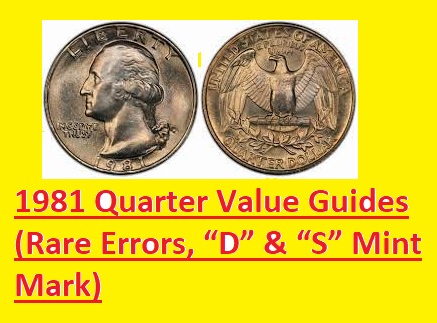
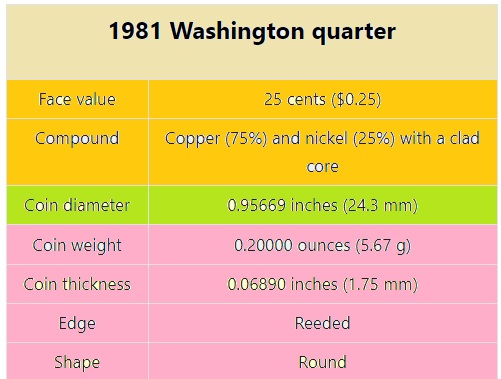
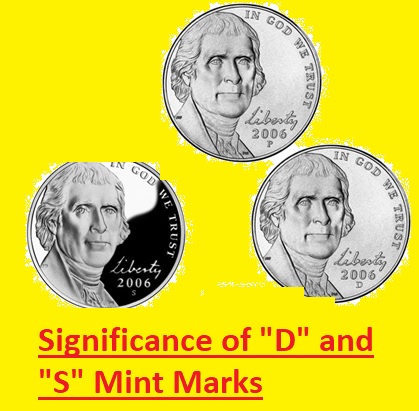
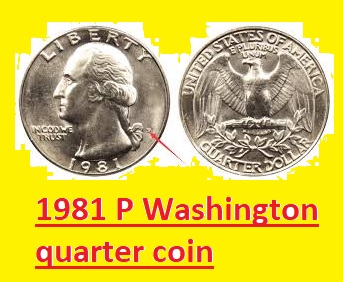
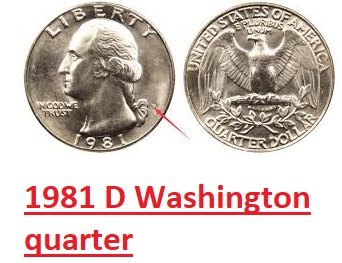
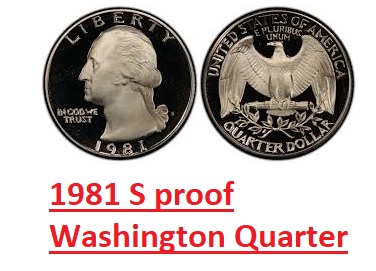
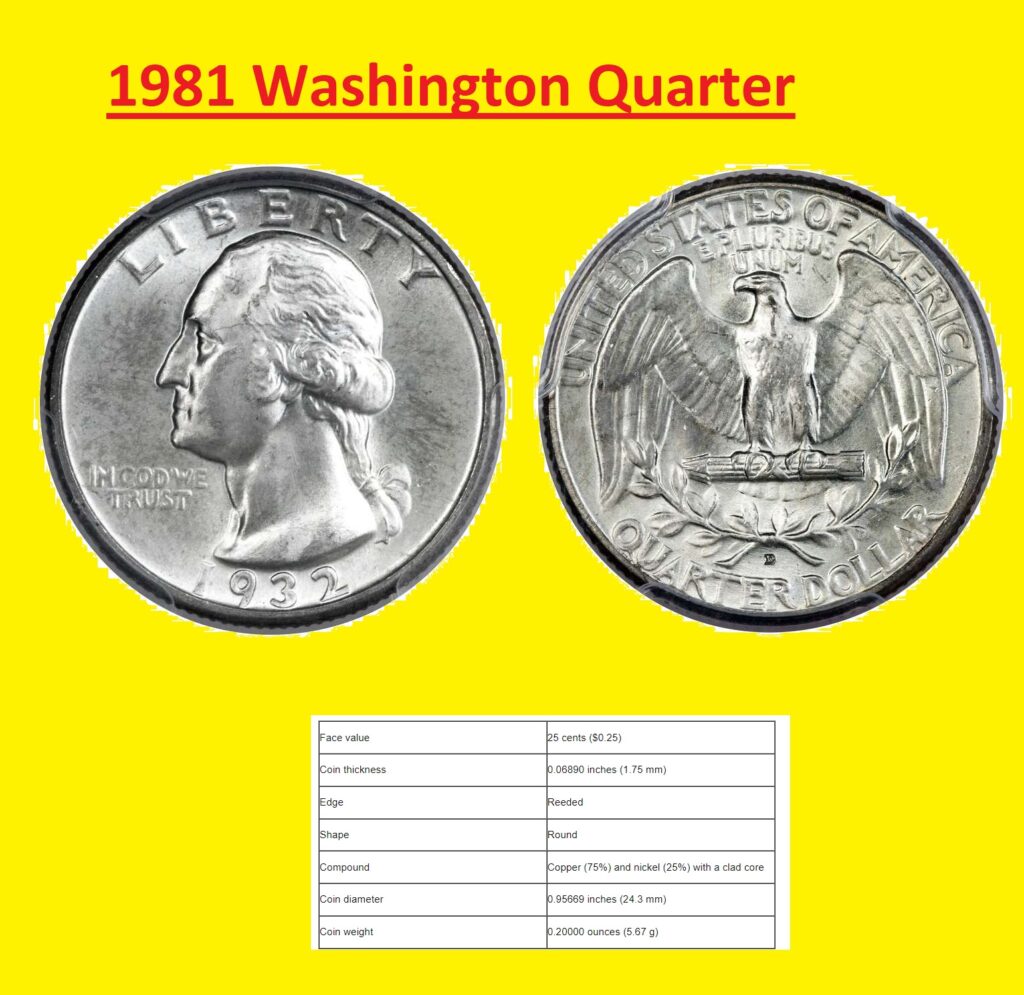






How much does a 1981 US quarter weigh?
quarter dollar coin is 0.955 inches in diameter and weighs 5.67 grams.
What Does The P Mint Mark Mean On A Quarter?
The P on 1981 quarter menas coins made at P mint. Coins with mint mark are of higher value than others without mint marks but condition and grade also affect the value